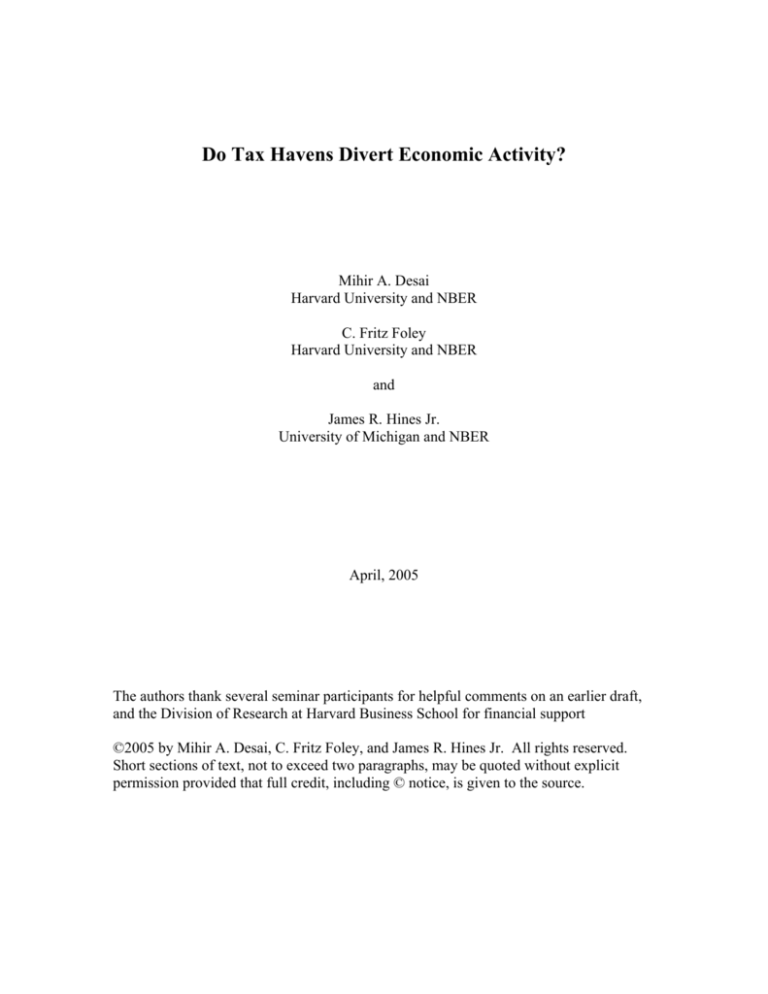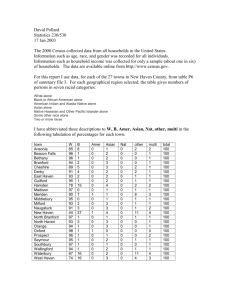
Do Tax Havens Divert Economic Activity?
Mihir A. Desai
Harvard University and NBER
C. Fritz Foley
Harvard University and NBER
and
James R. Hines Jr.
University of Michigan and NBER
April, 2005
The authors thank several seminar participants for helpful comments on an earlier draft,
and the Division of Research at Harvard Business School for financial support
©2005 by Mihir A. Desai, C. Fritz Foley, and James R. Hines Jr. All rights reserved.
Short sections of text, not to exceed two paragraphs, may be quoted without explicit
permission provided that full credit, including © notice, is given to the source.
1
Do Tax Havens Divert Economic Activity?
ABSTRACT
When multinational firms expand their operations in tax havens, do they divert
activity from non-havens? Much of the debate on tax competition presumes that the
answer to this question is yes. This paper offers a model for examining the relationship
between activity in havens and non-havens, and discusses the implications of recent
evidence in light of that model. Properly interpreted, the evidence suggests that tax
haven activity enhances activity in nearby non-havens.
JEL Classifications: H87, F23, F21.
Mihir A. Desai
Harvard Business School
Morgan 363
Soldiers Field
Boston, MA 02163
mdesai@hbs.edu
C. Fritz Foley
Harvard Business School
Morgan 389
Soldiers Field
Boston, MA 02163
ffoley@hbs.edu
James R. Hines Jr.
Department of Economics
University of Michigan
611 Tappan Street
Ann Arbor, MI 48109-1220
jrhines@umich.edu
1.
Introduction
Economic federations typically struggle with the impact and desirability of tax policy
diversity among member states. In particular, there is widespread concern that low-tax areas
within a federation impose a fiscal externality on other countries in attracting investment that
would otherwise locate in high-tax areas within the same regions. There are no reliable estimates
of the magnitude of such diversion. Moreover, there has been little consideration of the
possibility that reducing the costs of using of low-tax jurisdictions facilitates foreign investment
and economic activity in high-tax jurisdictions within the same regions. The latter possibility
arises if the ability to relocate taxable profits into low-tax jurisdictions increases the return to
investing in high-tax areas, if low-tax jurisdictions facilitate deferral of home-country taxation of
income earned elsewhere, or if affiliates in low-tax areas offer valuable intermediate goods and
services to affiliates in high-tax areas.
Tax havens also figure prominently in current debates over the scope and consequences
of tax competition. Countries competing for mobile foreign investment may have incentives to
reduce taxes to levels below what they would be in the absence of foreign competition; indeed,
there are circumstances in which international tax competition drives optimizing governments to
reduce all capital tax rates to zero.1 Tax havens are widely believed to accelerate the process of
tax competition between governments. However, it is conceivable that the tax avoidance
opportunities presented by tax havens allow other countries to maintain high capital tax rates
without suffering dramatic reductions in foreign direct investment. Hence the proliferation and
widespread use of tax havens may retard what would otherwise be aggressive competition
between other countries to reduce taxes in order to attract and maintain investment. Indeed,
1
The literature on tax competition since Oates (1972), as reviewed in Wilson (1999) and Gordon and Hines (2002),
has largely been theoretical, and focused on the possibility that tax competition may result in an inefficient
underprovision of public goods. An alternative stream of this literature emphasizes the virtues of tax competition in
restraining an expansive state, as argued in Brennan and Buchanan (1980) and modeled in Edwards and Keen
(1996). Further extensions of these models incorporate the political economy of fiscal policy and explore the
associated consequences for the efficiency of tax competition, as in Gordon and Wilson (2003) and Janeba and
Schjelderup (2002). Empirical efforts to consider the salience or consequences of tax competition include
Devereux, Lockwood and Redoano (2002), who estimate parameters of reaction functions within the OECD to
measure the extent to which tax competition has operated between 1982 and 1999, and Mendoza and Tesar (2002),
who simulate the dynamics of tax competition within Europe. Buettner (2003) analyzes fiscal competition within
Germany by considering the investment effects of tax policies in adjacent jurisdictions.
1
despite the incentives in place to compete over tax rates, the tax burden on corporate income in
OECD countries has fallen little, if at all, over the past 25 years (see Griffith and Klemm (2004)).
This paper presents a model that can be used to analyze the implications of evidence that
firms with growing activity in high-tax countries are also the firms most likely to initiate tax
haven operations. The complementarity between haven and non-haven activity, evident in this
empirical pattern, implies that reduced costs of using tax havens are likely to stimulate
investment in nearby high-tax countries. These results stand in contrast to the assumptions in
much of the tax competition literature and the beliefs of many concerned policymakers.
2.
A Model of Haven and Non-Haven Activity
Consider the incentives facing a firm with the option of making a discrete investment in a
tax haven location. Part of the return to investing in the tax haven comes in the form of reducing
the effective tax rate on the firm’s other foreign investments. Let τ 1 denote the tax rate on the
firm’s foreign investments outside of tax havens, and let τ 2 denote the effective tax rate on these
profits if the firm also has a tax haven operation. To the extent that the firm is able to use tax
haven investments to reduce effective foreign tax rates on income earned outside of havens, it
follows that τ 2 ≤ τ 1 .
The firm produces output in countries other than tax havens with a production function
Q(K1 , K 2 ) , in which K1 is the level of capital investment in non-havens, and K 2 is the level of
investment in tax havens. Firms are assumed to invest equity capital for which there is a shadow
cost represented by λ . The tax haven investment is taken to be discrete: the firm either invests
zero, or else invests a fixed amount of capital given by K 2* . The return to the tax haven
( )
~
investment is earned in the tax haven itself (where it is denoted Q K 2* ) and possibly by
augmenting profits earned in other foreign countries. Finally, there is a firm-specific cost of c1
per unit of capital invested in foreign countries outside the tax haven, and a cost of c2 per unit of
capital invested in the tax haven.
If the firm elects not to invest in the tax haven, its after-tax returns are given by:
2
π 1 ≡ (1 − τ 1 )Q(K1′,0) − λc1K1′ ,
(1)
in which K1′ is the profit-maximizing level of foreign investment, characterized by the first-order
condition:
′
(1 − τ 1 ) ∂Q(K1,0) = λc1 .
(2)
∂K1
If the firm instead chooses to invest in the tax haven, its returns are given by:
π 2 ≡ (1 − τ 2 )Q(K1* , K 2* ) + Q (K 2* ) − λ (c1K1* + c2 K 2* ) ,
~
(3)
in which K1* satisfies:
(1 − τ 2 ) ∂Q(K1 , K 2 ) = λc1 .
*
(4)
*
∂K1
The first-order conditions (2) and (4) together imply that K1′ and K1* satisfy:
(
)
(1 − τ 1 ) ∂Q(K1′,0) .
∂Q K1* , K 2*
=
(1 − τ 2 ) ∂K1
∂K1
(5)
Equation (5) identifies two channels by which the tax haven investment affects desired levels of
investment in other countries. The first comes from the tax rate reduction: since τ 2 ≤ τ 1 , it
follows that the ratio in the first term on the right side of (5) is less than or equal to one, which
implies that the favorable tax treatment afforded by tax havens may reduce the required pretax
marginal product of capital for non-haven operations of firms that simultaneously invest in
havens. The second effect of tax haven investment appears through the impact of such
investment on the marginal product of capital outside of havens.
Two extreme cases illustrate potential impacts of these two effects. If the marginal
product of capital in non-havens is not a function of the level of tax haven investment, or, more
formally, if
(
)
(
)
∂Q Kˆ 1 , K 2*
∂Q Kˆ 1 ,0
=
, ∀Kˆ 1 , K 2* ; and if τ 2 < τ 1 and the firm’s production function
∂K 1
∂K 1
3
exhibits the usual concavity in K1 , then the use of tax havens reduces the required marginal
product of capital elsewhere, so, from (5), K1* > K1′ . Alternative, it is possible that tax havens do
not appreciably reduce effective foreign tax rates, so τ 2 ≅ τ 1 ; and if the marginal product of
capital in non-havens falls as more capital is invested in havens (specifically, if
∂ 2Q(K1 , K 2 )
< 0 ), then it follows that K1* < K1′ . As these extreme cases make clear, the net
∂K1∂K 2
effect of tax haven investment on non-haven investment is ambiguous theoretically and must be
resolved empirically.
The firm’s optimization problem also suggests a method of evaluating the relationship
between haven and non-haven investment, since if having a tax haven operation increases the
desired level of non-haven investment (i.e., if K1* > K1′ ), then it is also the case that greater nonhaven investment increases the desirability of establishing a tax haven operation. What is the
impact on non-haven countries when an economic federation admits a tax haven as a new
member country, thereby reducing the cost that taxpayers incur in obtaining tax benefits from tax
haven operations? In the context of the model, such a move is represented as a reduction in c2 ,
the cost of operating in the tax haven. A change in tax regulations that reduces the cost of tax
avoidance through haven operations is another example of a policy that reduces c2 . Any
reduction in c2 increases the benefit (π 2 − π 1 ) associated with owning tax haven affiliates,
thereby encouraging firms to establish new haven affiliates. These new haven operations affect
investment elsewhere insofar as K 1* differs from K 1′ . While it should be possible to estimate the
effect of changes in c2 on foreign investment in high-tax locations, the practical difficulty of
identifying and measuring sufficient changes in the costs of using tax havens makes alternatives
considerably more appealing. One such alternative is to consider the effect of a change in c1 , the
cost of investing in non-havens, on the likelihood of establishing a tax haven affiliate, which is
an increasing function of (π 2 − π 1 ) .
Taking other features of the economic environment to be fixed, it is possible to write
(maximized) firm profits with and without tax haven operations as functions of investment costs,
thus π 2 (c1 ,c2 ) and π 1 (c1 ) . From the envelope condition characterizing profit maximization,
4
∂π 2 (c1 , c2 )
∂π 1 (c1 )
= −λK1* and
= −λK1′ . Hence the change in (π 2 − π 1 ) as c1 changes is given
∂c1
∂c1
by:
∂π 2 (c1 , c2 ) ∂π 1 (c1 )
−
= −λ K1* − K1′ .
∂c1
∂c1
(
(6)
)
Equation (6) indicates that, if K1* > K1′ , a reduced cost of investing in non-haven countries
increases the likelihood of establishing tax haven operations. Alternatively, if K1* < K1′ , a
reduced cost of investing in non-haven countries decreases the likelihood of establishing tax
haven operations. Equation (6) suggests that by observing changes in demand for tax haven
operations as c1 changes, it is possible to infer the effect of tax haven operations themselves on
investment elsewhere.
3.
Empirical Evidence
In order to implement the empirical method suggested by equation (6) it is necessary to
obtain a measure of c1 . A natural candidate is Tobin’s q, the ratio of the market value of capital
to its replacement cost, effectively a transformation of the user cost of capital. While Tobin’s q is
notoriously difficult to measure, it is, in theory, directly related to investment and other measures
of economic activity related to investment. Taking the q model of investment to imply that
I = βq , in which I is a firm’s investment level and β a scalar, it follows that q = β −1 I .
Consequently, a firm’s level of foreign direct investment serves as a proxy for q, and therefore
c1 . Of course, the endogeneity of investment to tax haven demand makes it necessary to use an
instrument for investment in order to estimate the impact of costs in non-havens on the
likelihood of establishing a tax haven affiliate.
A natural instrument for the change in firm i’s level of foreign direct investment in nontax haven countries is the economic growth rate of the countries in which it invests, weighted by
the levels of its initial investments. This instrument reflects country differences in q: economies
experiencing declining real costs of production, rising factor productivity, deregulatory episodes,
or other changes that increase the rate of local economic growth are also ones in which foreign
5
investors face lower net costs and are likely to expand their operations. Consequently, American
firms that invested heavily in economies that subsequently grew quickly tend to exhibit more
dramatic increases in foreign direct investment than do firms that instead invested heavily in
economies that subsequently grew slowly. Using this instrument, it is possible to evaluate the
effect of predicted changes in foreign investment in non-havens on the likelihood of establishing
a tax haven affiliate, thereby measuring the relationship expressed in equation (6).
Desai, Foley and Hines (forthcoming) present results that implement this approach.
While Desai, Foley and Hines interpret these results as confirming the effects of size of nonhaven activity on the demand for tax haven activities, it is possible to reinterpret their evidence
in light of the model presented in section 2. In their first-stage regressions, weighted GDP
growth rates correlate positively with growth of sales and growth of capital stocks in the same
regions, suggesting that GDP growth rates serve as reasonable instruments for changes in activity
outside of tax havens. The second stage regressions are fixed effect logit equations in which
predicted values of changes in sales and capital stocks of non-haven affiliates are used as
independent variables. The dependent variable takes the value one if a firm has no tax haven
affiliates in the region in the base period but has one or more tax haven affiliates in the region by
the next period in the analysis. The dependent variable is zero if a firm starts with one or more
tax haven affiliates only to lose them subsequently. Observations of firms that never have tax
haven affiliates, and those that always have tax haven affiliates, are excluded from the sample.
This procedure, developed by Chamberlain (1980), corresponds to a logit model with firm fixed
effects and permits straightforward estimation of how changes in non-haven demand, induced by
reduced costs of investing in such environments, affects the demand for tax haven operations.
The results indicate that greater activity outside of tax havens is associated with greater
demand for tax haven affiliates. Firms whose initial investments were concentrated in
economies that subsequently grew rapidly are the most likely to establish new tax haven
affiliates. The theory outlined in section 2 notes that this pattern implies that policies that reduce
the cost of using tax haven operations should stimulate greater economic activity among foreign
affiliates outside of tax havens. The regressions imply that, when evaluated at sample means, a
one percent greater likelihood of establishing a tax haven affiliate is associated with 0.5 to 0.7
percent greater sales and investment growth outside of tax havens within the same region.
6
4.
Conclusion
Contrary to many policy concerns and the assumptions of much of the tax competition
literature, reduced costs of using tax havens do not appear to divert activity from non-havens.
The empirical evidence indicates that firms facing reduced costs of establishing tax haven
operations respond in part by expanding their foreign activities in nearby high-tax countries.
Hence it appears that careful use of tax haven affiliates permits foreign investors to avoid some
of the tax burdens imposed by domestic and foreign authorities, thereby maintaining foreign
investment at levels exceeding those that would persist if tax havens were more costly.
The available macroeconomic evidence indicates that countries have not reduced their
taxation of foreign investment, or of capital income, to anything approximating the degree
implied by many models of capital tax competition. The use of tax havens by foreign investors
may help to explain this empirical pattern, as high-tax countries are able to maintain high tax
rates while continuing to draw significant levels of foreign investment. It is not even necessary
that high-tax countries are aware of the importance of tax havens in preserving their ability to
attract foreign investment. One further implication of this analysis is that tax harmonization
within federations may actually foster, rather than restrict, tax competition. Some initiatives to
harmonize tax rates would effectively raise the costs that investors face in order to obtain the
benefits of using tax havens, thereby reducing foreign investment in the region. Downward
pressure on national tax rates might well follow in an effort to attract investment, a process that
could have been made less likely with the diversity afforded by allowing havens within a region.
7
References
Brennan, Geoffrey and James Buchanan. (1980). The power to tax: Analytical foundations of a
fiscal constitution (New York: Cambridge University Press).
Buettner, Thiess. (2003). “Tax base effects and fiscal externalities of local capital taxation:
Evidence from a panel of German jurisdictions.” Journal of Urban Economics 54:110128.
Chamberlain, Gary. (1980). “Analysis of covariance with qualitative data.” Review of Economic
Studies 47:225-238.
Desai, Mihir A., C. Fritz Foley and James R. Hines Jr. (forthcoming). “The demand for tax
haven operations.” Journal of Public Economics.
Devereux, Michael P., Ben Lockwood and Michela Redoano. (2002) “Do countries compete
over corporate tax rates?” CEPR Working Paper 3400.
Edwards, Jeremy and Michael Keen. (1996). “Tax competition and Leviathan.” European
Economic Review 40:113-134.
Gordon, Roger H. and James R. Hines Jr. (2002). “International taxation.” in Alan J. Auerbach
and Martin Feldstein (eds.) Handbook of public economics, vol. 4 (Amsterdam: NorthHolland), 1935-1995.
Gordon, Roger H. and John D. Wilson. (2003). “Expenditure competition.” Journal of Public
Economic Theory 5:399-417.
Griffith, Rachel and Alexander Klemm. (2004). “What has been the tax competition experience
of the last 20 years?” Tax Notes International 34:1299-1315.
Janeba, Eckhard and Guttorm Schjelderup. (2002). “Why Europe should love tax competition –
and the U.S. even more so.” NBER Working Paper No. 9334.
Mendoza, Enrique G. and Linda L. Tesar. (2003). “A Quantitative Analysis of Tax Competition
v. Tax Coordination under Perfect Capital Mobility.” NBER Working Paper No. 9746.
Oates, Wallace. (1972). Fiscal federalism (New York: Harcourt Brace Jovanovich).
Wilson, John D. (1999). “Theories of tax competition.” National Tax Journal 52:269-304.
8







